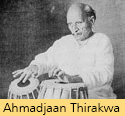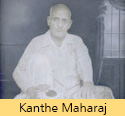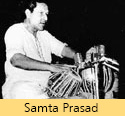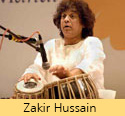
Indian Instrumental Music
Instrumental music occupies an important position in Indian music. It is one of the threefold aspects of "sangeet" (vocal music, instrumental music, and dance), and has a very ancient history. Instrumental music is known as "vadhya sangeet".
Most Indian instruments serve one of three functions. There is the melodic function, there is a rhythmic function, and there is the drone. It is not unusual for two or more functions to be joined together; for instance the sitar is a melodic instrument, yet built into it are drone strings. The tabla is a rhythmic instrument, yet the precise clear pitch of the instrument gives it some of the qualities of a drone.
There are many musical instruments in India. Some instruments are used primarily in north Indian music (Hindustani sangeet), some are used in the south Indian music (Carnatic sangeet), while others are found in folk music. Instrumental music is usually similar to vocal music but sometimes there are distinctive instrumental styles. There is a traditional system for the classification of instruments. This system is based upon; non-membranous percussion (ghan), membranous percussion (avanaddh), wind blown (sushir), plucked string (tat), bowed string (vitat).
Some instruments, which have made a great impact on Indian classical music are:
Sarod

The sarod is a stringed musical instrument, used mainly in Indian classical music. Along with the sitar, it is the most popular and prominent instrument in Hindustani (northern Indian) classical music. The sarod, usually played with a coconut-shell plectrum, is known for a deep, weighty, introspective sound with sympathetic strings that give it a resonant, reverberant quality. It is a fretless instrument able to produce the continuous slides between notes known as meend (glissandi), which are very important to Indian music. Notable artistes include: Allauddin Khan, Ali Akbar Khan, Ashis Khan, Timir Baran, Hafiz Ali Khan, Amjad Ali Khan; Shahjahanpur: Mohammad Amir Khan, Radhikamohan Maitra; Kaukuv Khan, Sakhawat Husain Khan, Irfan Muhammad Khan.
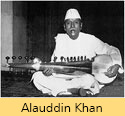

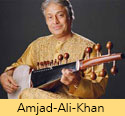


Sitar

The sitar is a plucked stringed instrument predominantly used in Hindustani classical music, where it has been ubiquitous since the Middle Ages. Usually played with a hard wire plectrum, it derives its resonance from sympathetic strings, a long hollow neck and a gourd resonating chamber. Notable artistes include:: Ravi Shankar, Nikhil Banerjee; Etawah: Enayet Khan, Vilayat Khan, Imrat Khan, Shahid Parvez Khan; Barkatullah Khan, Mushtaq Ali Khan.


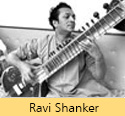
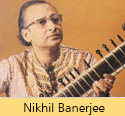
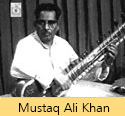
Santoor
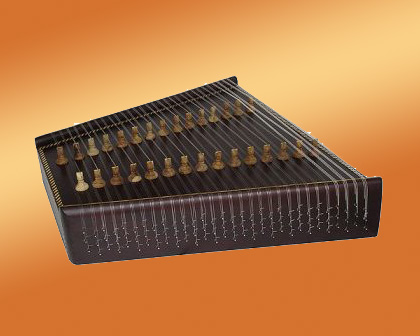
The santoor is an Indian stringed musical instrument. It is related to the Indian shata-tantri veena of earlier times. It is a trapezoid-shaped hammered dulcimer often made of walnut, with seventy strings. The special-shaped mallets (mezrab) are lightweight and are held between the index and middle fingers. A typical santoor has two sets of bridges, providing a range of three octaves. Made famous by the contemporary instrumentalist, Shivkumar Sharma.
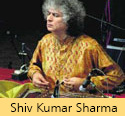
Violin

The violin is a bowed string instrument with four strings usually tuned in perfect fifths. It is the smallest and highest-pitched member of the violin family of string instruments, which also includes the viola and cello. The violin is sometimes informally called a fiddle, regardless of the type of music played on it. This Western instrument was adapted to both North Indian and Karnataki instrumental music. Used both for solo performance and accompaniment. Notable artistes include: Allauddin Khan, Gajananbua Joshi, VG Jog, Sisirkana Dhar Chaudhury.
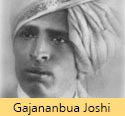

Flute
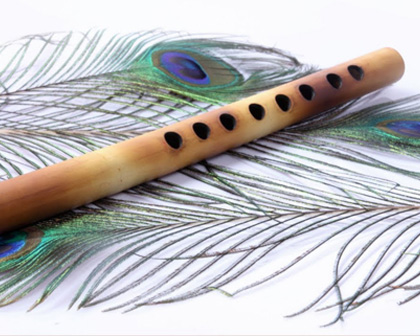
The variety most used in North Indian Classical Music is the bansuri, associated in myth with the God Krishna. It is held crosswise across the lips. Notable artistes include: Pannalal Ghosh, Hariprasad Chaurasiya.
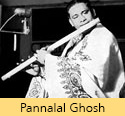
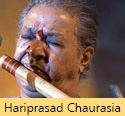
Shehnai

The Shehnai is an aerophonic instrument, which is thought to bring good luck and as a result, is widely used in India for marriages and processions. This tube-like instrument gradually broadens towards the lower end. It usually has between six and nine holes. It employs two sets of double reeds, making it a quadruple reed woodwind. By controlling the breath, various tunes can be played on it. Made into a major concert instrument by Ustad Bismillah Khan of Banaras. Notable artistes include: Bismillah Khan, Ali Ahmad Husain.
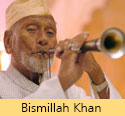

Sarangi

The Sarangi is a bowed, short-necked lute of the Indian subcontinent. It is an important bowed string instrument of India's Hindustani classical music tradition. Of all Indian instruments, it is said to most resemble the sound of the human voice – able to imitate vocal ornaments such as gamakas (shakes) and meend (sliding movements). It is also said to be the hardest Indian instrument to master. Notable artistes include: Bundu Khan, Sagiruddin Khan, Ram Narayan, Dhruba Ghosh.

Pakhawaj

The Pakhavaj is a barrel-shaped, two-headed drum, the North Indian equivalent to the Southern mridangam. It is the standard percussion instrument in the dhrupad style and is widely used as an accompaniment for various forms of music and dance performances. The pakhavaj has a low, mellow tone, very rich in harmonics. Set horizontally on a cushion in front of the drummer's crossed leg, the larger bass-skin is played with the left hand, the treble skin by the right hand. Notable artistes include: Raja Chhatrapati Singh, Arjun Shejwal.
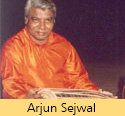
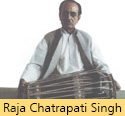

Tabla
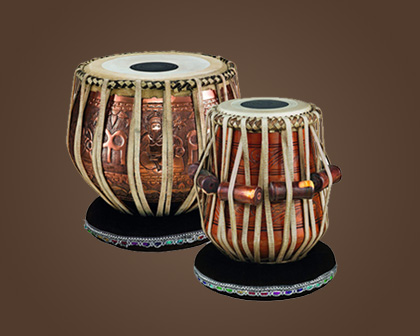
The tabla is a popular Indian percussion instrument used in the classical, popular and devotional music of the Indian subcontinent and in Hindustani classical music. The instrument consists of a pair of hand drums of contrasting sizes and timbres. Notable artistes include: Inam Ali Khan, Shafat Ali Khan: Ahmad Jan Thirakwa, Ameer Husain Khan, Habibuddin Khan, Keramatullah Khan, Nizamuddin Khan; Kanthe Maharaj, Kishan Maharaj, Anokhelal Mishra, Samta Prasad; Wajid Husain Khan. Afaq Husain Khan; Allah Rakha, Zakir Husain.
